
(a)
Interpretation:
The product of the given reaction is to be predicted, considering one molar equivalent of
Concept introduction:
The C=C functional group of an alkene or the
Answer to Problem 19.54P
The product of the given reaction is

Explanation of Solution
The given reaction is
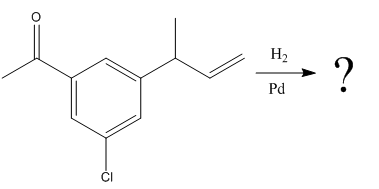
The given reaction condition correlates to catalytic hydrogenation; it reduces alkene’s C=C over ketone’s C=O. Thus, the
Therefore, the product of the given reaction is
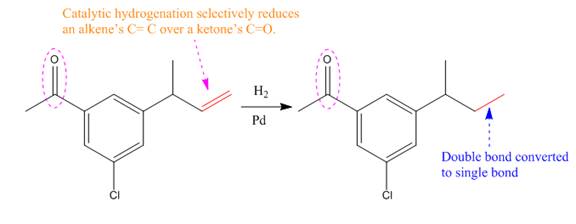
The product of the given reaction is predicted using the given reaction conditions.
(b)
Interpretation:
The product of the given reaction is to be predicted, considering one molar equivalent of
Concept introduction:
The C=C functional group of an alkene or the
Catalytic hydrogenation is more favored at a less sterically hindered multiple bond than at a more sterically hindered one.
Answer to Problem 19.54P
The product of the given reaction is
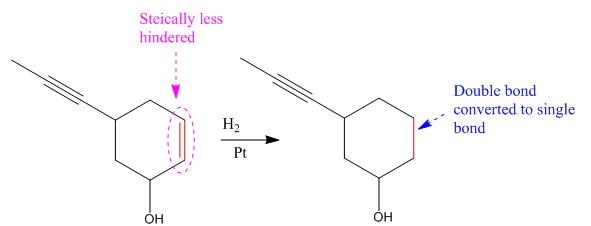
Explanation of Solution
The given reaction
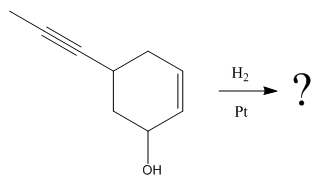
The given reaction condition correlates to catalytic hydrogenation. The substrate in the given reaction have two sites for catalytic hydrogenation, one C=C bond and another
Catalytic hydrogenation is more favored at a less sterically hindered multiple bond than at a more sterically hindered one.
In the given reaction, the C=C bond is sterically less hindered; therefore the

The product of the given reaction is predicted using given reaction conditions.
(c)
Interpretation:
The product of the given reaction is to be predicted, considering one molar equivalent of
Concept introduction:
The C=C functional group of an alkene or the
Answer to Problem 19.54P
The product of the given reaction is

Explanation of Solution
The given reaction is
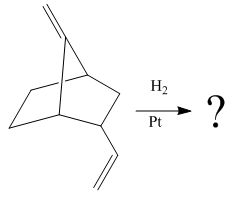
The given reaction condition correlates to catalytic hydrogenation. The substrate in the given reaction have two sites for catalytic hydrogenation, two C=C bonds.
Catalytic hydrogenation is more favored at a less sterically hindered multiple bond than at a more sterically hindered one.
In the given reaction, the C=C bond is at bottom is sterically less hindered; therefore the

The product of the given reaction is predicted using the given reaction conditions.
(d)
Interpretation:
The product of the given reaction is to be predicted, considering one molar equivalent of
Concept introduction:
The C=C functional group of an alkene or the
Answer to Problem 19.54P
The product of the given reaction is

Explanation of Solution
The given reaction is

The given reaction condition correlates to catalytic hydrogenation. The substrate in the given reaction has two sites for catalytic hydrogenation, one
The functional groups in alkenes, alkynes, and aldehydes can be selectively reduced over those in ketones, nitriles, and amides. Thus, the
Therefore, the product of the given reaction is

The product of the given reaction is predicted using the given reaction conditions.
(e)
Interpretation:
The product of the given reaction is to be predicted, considering one molar equivalent of
Concept introduction:
The C=C functional group of an alkene or the
Answer to Problem 19.54P
The product of the given reaction is

Explanation of Solution
The given reaction is

The given reaction condition correlates to catalytic hydrogenation. The substrate in the given reaction has two sites for catalytic hydrogenation, one C=C bond and another the nitrile group.
The functional group ketones can be selectively reduced over nitriles. Thus, the
Therefore, the product of the given reaction is

The product of the given reaction is predicted using the given reaction conditions.
(f)
Interpretation:
The product of the given reaction is to be predicted, considering one molar equivalent of
Concept introduction:
The C=C functional group of an alkene or the
Answer to Problem 19.54P
The product of the given reaction is
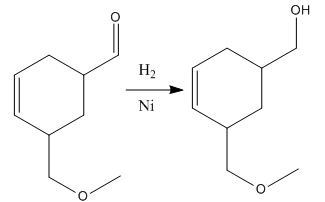
Explanation of Solution
The given reaction is
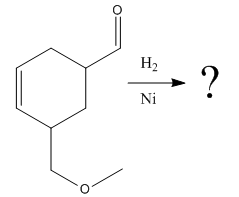
The given reaction condition correlates to catalytic hydrogenation. The substrate in the given reaction has two sites for catalytic hydrogenation, one C=C bond and another the aldehyde group.
Aldehydes and alkenes have similar reactivity toward catalytic hydrogenation, but the aldehyde group in the above substrate is less sterically hindered; thus
Therefore, the product of the given reaction is
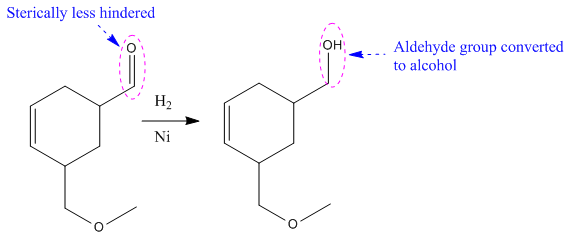
The product of the given reaction is predicted using the given reaction conditions.
(g)
Interpretation:
The product of the given reaction is to be predicted, considering one molar equivalent of
Concept introduction:
The C=C functional group of an alkene or the
Answer to Problem 19.54P
The product of the given reaction is

Explanation of Solution
The given reaction is

The given reaction condition correlates to catalytic hydrogenation. The substrate in the given reaction has two sites for catalytic hydrogenation, one
The functional groups in alkenes, alkynes, and aldehydes can be selectively reduced over those in ketones, nitriles, and amides. Thus, the
Therefore, the product of the given reaction is

The product of the given reaction is predicted using the given reaction conditions.
Want to see more full solutions like this?
Chapter 19 Solutions
EBK ORGANIC CHEMISTRY: PRINCIPLES AND M
- A mixture of C7H12O2, C9H9OCl, biphenyl and acetone was put together in a gas chromatography tube. Please decide from the GC resutls which correspond to the peak for C7,C9 and biphenyl and explain the reasoning based on GC results. Eliminate unnecessary peaks from Gas Chromatography results.arrow_forwardIs the molecule chiral, meso, or achiral? CI .CH3 H₂C CIarrow_forwardPLEASE HELP ! URGENT!arrow_forward
- Identify priority of the substituents: CH3arrow_forwardHow many chiral carbons are in the molecule? OH F CI Brarrow_forwardA mixture of three compounds Phen-A, Acet-B and Rin-C was analyzed using TLC with 1:9 ethanol: hexane as the mobile phase. The TLC plate showed three spots of R, 0.1 and 0.2 and 0.3. Which of the three compounds (Phen-A; Acet-B or Rin-C) would have the highest (Blank 1), middle (Blank 2) and lowest (Blank 3) spot respectively? 0 CH: 0 CH, 0 H.C OH H.CN OH Acet-B Rin-C phen-A A A <arrow_forward
 ChemistryChemistryISBN:9781305957404Author:Steven S. Zumdahl, Susan A. Zumdahl, Donald J. DeCostePublisher:Cengage Learning
ChemistryChemistryISBN:9781305957404Author:Steven S. Zumdahl, Susan A. Zumdahl, Donald J. DeCostePublisher:Cengage Learning ChemistryChemistryISBN:9781259911156Author:Raymond Chang Dr., Jason Overby ProfessorPublisher:McGraw-Hill Education
ChemistryChemistryISBN:9781259911156Author:Raymond Chang Dr., Jason Overby ProfessorPublisher:McGraw-Hill Education Principles of Instrumental AnalysisChemistryISBN:9781305577213Author:Douglas A. Skoog, F. James Holler, Stanley R. CrouchPublisher:Cengage Learning
Principles of Instrumental AnalysisChemistryISBN:9781305577213Author:Douglas A. Skoog, F. James Holler, Stanley R. CrouchPublisher:Cengage Learning Organic ChemistryChemistryISBN:9780078021558Author:Janice Gorzynski Smith Dr.Publisher:McGraw-Hill Education
Organic ChemistryChemistryISBN:9780078021558Author:Janice Gorzynski Smith Dr.Publisher:McGraw-Hill Education Chemistry: Principles and ReactionsChemistryISBN:9781305079373Author:William L. Masterton, Cecile N. HurleyPublisher:Cengage Learning
Chemistry: Principles and ReactionsChemistryISBN:9781305079373Author:William L. Masterton, Cecile N. HurleyPublisher:Cengage Learning Elementary Principles of Chemical Processes, Bind...ChemistryISBN:9781118431221Author:Richard M. Felder, Ronald W. Rousseau, Lisa G. BullardPublisher:WILEY
Elementary Principles of Chemical Processes, Bind...ChemistryISBN:9781118431221Author:Richard M. Felder, Ronald W. Rousseau, Lisa G. BullardPublisher:WILEY





